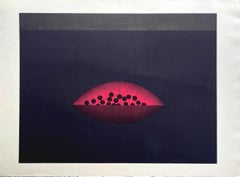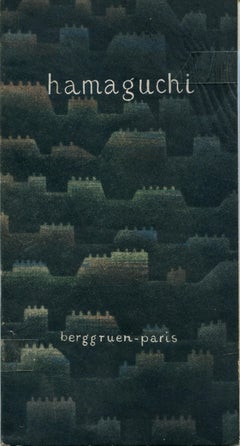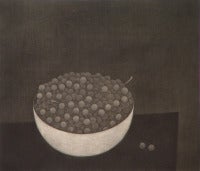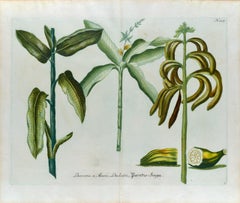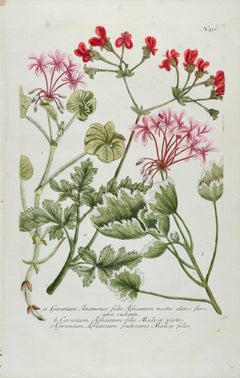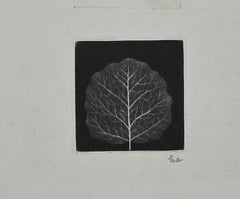Yozo Hamaguchi Art
Japanese, 1909-2000
Yozo Hamaguchi, printmaker, was born in Wakayama, Japan in 1909, the son of Gihei, who was the tenth president of the soy sauce producer Yamasa Shoyu. Originally considered to be the next in line to take over the company, Hamaguchi was instead drawn to visual arts, inspired by the works that his father, a Nanga painting collector, kept throughout the house. In 1927 Hamaguchi left the family business to enroll in the Tokyo Art School, training in sculpture. He left the school in 1930 and moved to France on the advice of artist Umehara Ryuzaburo, opting to study modern Western art and the techniques of oil painting, printmaking, and watercolor. He lived there until 1939, becoming acquainted with leading international artists and luminaries, including the writer e.e. cummings who was instrumental in introducing him to mezzotint printmaking.
With the outbreak of World War II, Hamaguchi returned once more to Japan. There he met artist Keiko Minami, whom he would later marry. Throughout the 1940s he established himself as a pioneering mezzotint artist, often credited with introducing the medium to his birthplace. His style - graphic, subtle, and primarily in a monochromatic palette - gained widespread popularity throughout Europe and, in 1951, he held his first solo exhibition at the Formes Gallery in Tokyo. Around 1953 Hamaguchi and Minami returned to France, settling in Paris and, in 1954, he became a member of the Salon d'Automne. That same year he won the Best Art Piece prize at the Contemporary Art Exhibition of Japan. In 1955 he began experimenting with color as well as abstraction, retaining his refined tonality, to acclaim from critics, artists, and institutions. He won the Grand Prize of the International Printmaking Division at the San Paolo Biennial in 1957, and that same year he participated in the first International Biennial Print Exhibition in Tokyo, where he won the National Museum of Modern Art (Tokyo) Prize. In 1960 served as representative of the Japan Pavilion at the Venice Biennale.
Hamaguchi's compositions were usually the still life genre, simplifying the elements and suspending them against velvety grounds in a signature style that appealed strongly to western patrons. In 1961 Hamaguchi and Minami moved from Paris to San Francisco, California, where they lived until 1996. During this time, he was commissioned by the Olympic Committee to design the official poster for the 1984 Sarajevo Winter Olympics and the following year he was given his first major retrospective in Japan at the Toyo Yurakucho Art Forum. Hamaguchi continued to work and exhibit his mezzotints until his retirement in 1993, leaving the printing of his plates to his publisher. He and Minami returned to Tokyo in 1996, and in 1998 the Musée Hamaguchi Yozo was established in Tokyo. Hamaguchi is credited as being among the many 20th century artists to help revive the 17th century intaglio technique, promoting mezzotint as a viable modern art form appropriate for the expressive genres of the time. His work has been exhibited in prominent museums & galleries worldwide(Biography provided by Bloomsbury Fine Art & Antiques)
to
3
1
2
2
2
2
Overall Height
to
Overall Width
to
1
1
1
1
1
4
2
1
1
4
6,996
3,348
2,513
1,213
3
2
Artist: Yozo Hamaguchi
Black Cherries
By Yozo Hamaguchi
Located in Paris, FR
Engraving, 1965
Publisher : Éditions Berggruen, Paris
56.00 cm. x 76.00 cm. 22.05 in. x 29.92 in. (paper)
47.00 cm. x 62.50 cm. 18.5 in. x 24.61 in. (image)
Mezzotint
BFK Rives pap...
Category
1960s Abstract Yozo Hamaguchi Art
Materials
Engraving
Hamaguchi - Rare Catalogue of Exhibition at Galerie Berggruen - 1958
By Yozo Hamaguchi
Located in Roma, IT
Vintage and rare catalogue of the works exhibited by Hamaguchi at Berggruen Gallery in 1958. Includes reproduction of works and their descriptions. Language: French. Very good condit...
Category
1950s Yozo Hamaguchi Art
Materials
Other Medium
Walnut - Original Mezzotint by Yozo Hamaguchi - 1979
By Yozo Hamaguchi
Located in Roma, IT
Walnut is an original mezantint on paper realized in 1979 by the Japanese artist Yozo Hamaguchi. The artwork is hand- signed by the artist in pencil on lower right. Dedicated with a...
Category
1970s Yozo Hamaguchi Art
Materials
Mezzotint
Grapes
By Yozo Hamaguchi
Located in Dallas, TX
épreuve d'artiste 2/5
Category
1950s Yozo Hamaguchi Art
Materials
Mezzotint
Related Items
Banana Plants: An 18th Century Hand-colored Botanical Engraving by J. Weinmann
By Johann Wilhelm Weinmann
Located in Alamo, CA
This is a striking original antique colored botanical mezzotint and line double page engraving of banana plants, which is finished with hand-coloring. It is entitled "Banana 1. Musa,...
Category
Mid-18th Century Naturalistic Yozo Hamaguchi Art
Materials
Engraving, Mezzotint
Red Geranium: An 18th Century Hand-colored Botanical Engraving by J. Weinmann
By Johann Wilhelm Weinmann
Located in Alamo, CA
This is an original antique colored botanical mezzotint and line engraving of flowering Red Geraniums which is finished with hand-coloring. It is entitled "Geranium Anemones folio Af...
Category
Mid-18th Century Naturalistic Yozo Hamaguchi Art
Materials
Engraving, Mezzotint
Genesis
Located in Toronto, ON
About her Stratified Finger Pots - Clay is an incredibly responsive and versatility material. These pieces were inspired by Hoodoo landscape of southern Alberta, Canada. The surface ...
Category
21st Century and Contemporary Yozo Hamaguchi Art
Materials
Ceramic, Glaze
Late Night (Where Berkeley Place meets Seventh Avenue in Brooklyn's Park Slope)
By Frederick Mershimer
Located in New Orleans, LA
In "Late Night", Frederick Mershimer created a winter scene where Berkeley Place meets Seventh Avenue in Brooklyn's Park Slope. This image, the seventh in t...
Category
1990s Contemporary Yozo Hamaguchi Art
Materials
Mezzotint, Aquatint
Lafitte's Blacksmith House (a bar named for a pirate on Bourbon St, New Orleans)
By Frederick Mershimer
Located in New Orleans, LA
Lafitte's Blacksmith Shop is a New Orleans landmark at 941 Bourbon St. Like most New Orleans legends, history of Lafitte's Blacksmith Shop is a gumbo of tru...
Category
Early 2000s Contemporary Yozo Hamaguchi Art
Materials
Mezzotint, Aquatint
Cotton Plant: An 18th Century Hand-colored Botanical Engraving by J. Weinmann
By Johann Wilhelm Weinmann
Located in Alamo, CA
This striking hand-colored botanical mezzotint and line engraving is entitled "Gnaphalium, Gossypium (Cotton Plant)". It is plate 551 in Johann Weinmann's monumental publication "Phy...
Category
Mid-18th Century Naturalistic Yozo Hamaguchi Art
Materials
Engraving, Mezzotint
VANS limited edition MURAKAMI Skull 8.5us/43 new/ Brand New 2015 collector
By Takashi Murakami
Located in Saint Ouen, FR
VANS
edition limitée MURAKAMI
Skull
8.5us/43
neuves/ Brand New
2015
collector !
Category
21st Century and Contemporary Contemporary Yozo Hamaguchi Art
Materials
Textile
H 3.15 in W 3.15 in D 11.42 in
Portrait of Gentleman, Thomas Bruce, Earl of Elgin c.1638 Manor House Provenance
Located in London, GB
Titan Fine Art present this picture which formed part of a historic collection of an English aristocratic family, Lord and Lady Sandys at their magnificent baroque and Regency Grade-I listed family home, Ombersley Court. The house was among the most fascinating survivals of its kind in this country. The atmospheric interiors were distinguished above all for the works of art associated with two key moments in national history and, more specifically, to the roles of Colonel the Hon. John Russell in the Civil War and the reign of King Charles II and of Lord Arthur Hill, later 2nd Baron Sandys, in the Peninsular War. The collection was acquired or commissioned over five centuries and remained at Ombersley Court until its recent sale, the first in 294 years. This painting hung in The Great Hall (see photo).
This charming portrait is an example of the type of small-scale panel portraits, often of splendid beauties of the time, that became fashionable from about the first quarter of the seventeenth century. The sitter has been depicted wearing a low-cut silk dress with the wide billowing sleeves typical of the late 1630’s. The simplicity of the ensemble is reinforced by the absence of lace on either the collar or cuffs. At this time gone are the complicated layers of fabrics, and now replaced with understated elegance of plain silk (satin and taffeta were most popular), with only a couple of focal points as accessories. There is an abundance of the accessory par excellence – pearls, and they are worn as a necklace, on her attire, and as earrings; the pear-shaped earrings are called ‘unions excellence’ reflecting the difficulty of finding perfectly matched pearls of such large size. They could range up to 20 millimetres in diameter. There is a splendid display of gold, diamond and pearl jewellery which is an obvious sign of her wealth.
The portrait is thought to represent Thomas Bruce (1596-1654), Earl of Elgin. The physiognomy and features in our portrait strongly correlate to a portrait of the Earl, by Cornelius Johnson (1593-1661), painted circa 1638, and is held at Kenwood House, London. Another painting from Ombersley Court, also with Titan Fine Art, is contemporaneous to ours and is thought to represent the Earl’s wife, Diana Cecil, 1st Countess of Elgin (c.1603-1654) - it appears to have derived from Cornelius Johnson’s depiction of the Countess circa 1638, also at Kenwood House. During the 1630’s Johnson painted a number of portraits, obviously influenced by Van Dyke. Here, Theodore Russel, who worked in the studios of both Van Dyle and Johnson, and later specialised in small scale reproductions of his master’s works, modelled the head, with the striking large dark eyes, on Cornelius Johnson, and the attire on Anthony van Dyke. There are also other portraits by Johnson of the sitter with very similar facial features to that of the sitter in ours. Theodore Russel and Cornelius Johnson also had a family connection as it is thought that Russel’s step-mother was a sister of Johnson.
Thomas Bruce, 1st Earl of Elgin, was a prominent Scottish nobleman who held titles such as the 3rd Lord Bruce of Kinloss. He resided at Houghton House in Bedfordshire and played a significant role in the political and social landscape of his time. His legacy as an Earl and Lord continues to be remembered in history.
Thomas Bruce, born in Edinburgh in 1599, inherited the Scottish peerage title as the 3rd Lord Bruce of Kinloss at the age of 13 following his brother's untimely death in a duel. The family's estates, including Whorlton Castle and manor, were granted by King James I of England to Thomas's father, with the wardship of Thomas and the estates entrusted to his mother until he reached the age of 21. He maintained a strong connection with King Charles I's court during the Personal Rule, receiving titles of honour and prestigious roles throughout the years.
Thomas Bruce was married twice in his lifetime. His first marriage was to Anne Chichester in 1622. Ann died in 1627, the day after giving birth to their only child, Robert Bruce, who later became the 1st Earl of Ailesbury. On 12 November 1629, Thomas Bruce married Lady Diana Cecil, the daughter of William Cecil and widow of Henry de Vere. The marriage was childless, but Diana brought significant estates with her. Thomas Bruce died on 21 December 1663 at the age of 64.
This oil on panel portrait has been well cared for over its life, which spans almost four centuries. Having recently undergone a treatment to remove an obscuring discoloured varnish, it can be fully appreciated, and attributed to Theodore Russel.
Once owned by Evesham Abbey, the manor of Ombersley was acquired by the Sandys family in the early 1600s, when Sir Samuel Sandys, the eldest son of Edwin Sandys, Bishop of Worcester and later Archbishop of York, took a lease on the manor, before receiving an outright grant in 1614. The present house, Ombersley Court, dates from the time of Samuel, 1st Lord Sandys, between 1723 and 1730. The house itself is a fine example of an English Georgian country house set in rolling countryside and surrounded by Wellingtonias, planted to commemorate the Battle of Waterloo by Arthur Hill, 2nd Baron Sandys, who played a distinguished part in the battle and was one of the Duke of Wellington’s aides de camp. The Duke also stayed in the house and in the Great Hall, was the Waterloo banner which was brought to the house by Sir Arthur Hill, aide-de-camp to the Duke of Wellington, who succeeded his mother, the Marchioness of Downshire as 2nd Lord Sandys. Further Waterloo memorabilia are kettle drums from battle. The family had a strong tradition of military and political service, dating back to the 17th century, and this was also reflected in the fine collection of portraits and paintings in the house. In short, Ombersley represented a vital aspect of British history. The house and more especially the collection were of the greatest historical importance. Houses that have remained in the possession of the same family for as many as three centuries have become increasingly rare.
Through this portrait, collectors have a chance to acquire a piece of British history and an evocative vestige of a glittering way of life, which is now gone.
Presented in a fine period frame.
Theodore Russell, or Roussel, was born in London in 1614. His father came from Bruges to England and was the Royal Stuart jeweller. His apprenticeship was spent in the studio of his uncle, Cornelius Johnson, with whom he lived for about nine years. Sometime after 1632, he is said to have worked as an assistance to Van Dyck. He executed numerous copies of portraits by his famous master and other notable painters, also painting original works. He is particularly remembered for his portraits of Charles II at Woburn Abbey and James II at the Palace of Holyrood. His son, Antony Russel (c.1663–1743) was also a portrait-painter and is said to have studied under John Riley. Several of his copies were in the Royal Collections, and among the nobility.
Provenance
Richard Hill...
Category
17th Century Old Masters Yozo Hamaguchi Art
Materials
Oil, Wood Panel
H 18.9 in W 16.15 in D 1.58 in
Large Italian Aquatint Etching Francesco Clemente Neo Expressionist Avant Garde
By Francesco Clemente
Located in Surfside, FL
Francesco Clemente (Italian b. 1952),
'This side up / Telemone #2,
1981
Medium: Intaglio hard ground etching, color aquatint, drypoint, and soft-ground etching with chine collé (ha...
Category
1980s Abstract Expressionist Yozo Hamaguchi Art
Materials
Drypoint, Etching, Aquatint, Intaglio
"The Fern Gatherers" 18th Century Antique Mezzotint Engraving by John R. Smith
By George Morland
Located in Carmel, CA
"The Fern Gatherers" After a painting by George Morland. 1763-1804. - Mezzotint engraving by John Raphael Smith. 1752-1812.
Print: 20.75" x 26" - With Frame: 28" x 33.5"
Published:...
Category
Late 18th Century Realist Yozo Hamaguchi Art
Materials
Mezzotint, Engraving
H 20.75 in W 26 in D 0.07 in
Johann Weinmann: c18th Botanical Engravings in Decalcomania Frames
Located in Richmond, GB
A wonderful selection of hand-coloured mezzotint engravings from: ""Phytanthoza Iconographia"", c1739, presented in hand- made parcel-gilt, ebonised and decalcomania frames.
Joha...
Category
18th Century Yozo Hamaguchi Art
Materials
Watercolor, Mezzotint
Portrait of a Lady Diana Cecil, Countess of Elgin c.1638, Manor House Provenance
Located in London, GB
Titan Fine Art present this picture which formed part of a historic collection of an English aristocratic family, Lord and Lady Sandys at their magnificent baroque and Regency Grade-I listed family home, Ombersley Court. The house was among the most fascinating survivals of its kind in this country. The atmospheric interiors were distinguished above all for the works of art associated with two key moments in national history and, more specifically, to the roles of Colonel the Hon. John Russell in the Civil War and the reign of King Charles II and of Lord Arthur Hill, later 2nd Baron Sandys, in the Peninsular War. The collection was acquired or commissioned over five centuries and remained at Ombersley Court until its recent sale, the first in 294 years. This painting hung in The Great Hall (see photo).
This charming portrait is an example of the type of small-scale panel portraits, often of splendid beauties of the time, that became fashionable from about the first quarter of the seventeenth century. The sitter has been depicted wearing a low-cut silk dress with the wide billowing sleeves typical of the late 1630’s. The simplicity of the ensemble is reinforced by the absence of lace on either the collar or cuffs. At this fashion moved away from complicated layers of fabrics to an understated elegance of plain silk (satin and taffeta were most popular) with only a couple of focal points as accessories. However, obligatory for any respectable woman, pears are shown in abundance, as a necklace, on the dress attire, and pear-shaped earrings called ‘unions excellence’ reflecting the difficulty of finding perfectly matched pearls of such large size. They could range up to 20 millimetres in diameter. There is a splendid display of gold, diamond and pearl jewellery which is an obvious sign of her wealth.
The subject is thought to be Diana Bruce née Cecil, 1st Countess of Elgin (c.1603-1654). The physiognomy and features strongly correlate to a portrait of the countess by Cornelius Johnson (1593-1661), painted circa 1638, at Kenwood House, London. Another painting from Ombersley Court, also with Titan Fine Art, is contemporaneous to this and is thought to represent the countess’s husband, Thomas Bruce, 1st Earl of Elgin (1599-1663) – it appears to have derived from Cornelius Johnson’s portrait of the Earl, of circa 1638, also at Kenwood House. During the 1630’s Johnson painted a number of portraits, obviously influenced by Van Dyke. Here, Theodore Russel, who worked in the studios of both Van Dyle and Johnson, and later specialised in small scale reproductions of his master’s works, appears to have modelled the head, with the striking large dark eyes, on Cornelius Johnson, and the attire on Anthony van Dyke. Theodore Russel and Cornelius Johnson also had a family connection as it is thought that Russel’s step-mother was a sister of Johnson.
Diana Cecil, Countess of Oxford (1596–1654), later Countess of Elgin, was an English aristocrat. She was probably the middle daughter of the three daughters of William Cecil, 2nd Earl of Exeter and Elizabeth Drury. Her first husband, Henry de Vere, 18th Earl of Oxford, died in battle only 18 months after their marriage in 1624. She married her second husband Thomas Bruce (1599-I663) in 1629, becoming the Countess of Elgin in 1633. Her portrait was presumably painted at a similar time as the companion portrait of her husband, the Earl of Elgin. She died in 1654, outlived by her husband and leaving no children. A large monument exists of the countess in her burial shroud at Ailesbury Mausoleum, Bedfordshire.
The work has been well cared for over its life, which spanning almost four centuries, and having recently undergone a treatment to remove an obscuring discoloured varnish, it can be fully appreciated, and attributed to Theodore Russel.
Once owned by Evesham Abbey, the manor of Ombersley was acquired by the Sandys family in the early 1600s, when Sir Samuel Sandys, the eldest son of Edwin Sandys, Bishop of Worcester and later Archbishop of York, took a lease on the manor, before receiving an outright grant in 1614. The present house, Ombersley Court, dates from the time of Samuel, 1st Lord Sandys, between 1723 and 1730. The house itself is a fine example of an English Georgian country house set in rolling countryside and surrounded by Wellingtonias, planted to commemorate the Battle of Waterloo by Arthur Hill, 2nd Baron Sandys, who played a distinguished part in the battle and was one of the Duke of Wellington’s aides de camp. The Duke also stayed in the house and in the Great Hall, was the Waterloo banner which was brought to the house by Sir Arthur Hill, aide-de-camp to the Duke of Wellington, who succeeded his mother, the Marchioness of Downshire as 2nd Lord Sandys. Further Waterloo memorabilia are kettle drums from battle. The family had a strong tradition of military and political service, dating back to the 17th century, and this was also reflected in the fine collection of portraits and paintings in the house. In short, Ombersley represented a vital aspect of British history. The house and more especially the collection were of the greatest historical importance. Houses that have remained in the possession of the same family for as many as three centuries have become increasingly rare.
Through this portrait, collectors have a chance to acquire a piece of British history and an evocative vestige of a glittering way of life, which is now gone.
Presented in a fine period frame.
Theodore Russell, or Roussel, was born in London in 1614. His father came from Bruges to England and was the Royal Stuart jeweller. His apprenticeship was spent in the studio of his uncle, Cornelius Johnson, with whom he lived for about nine years. Sometime after 1632, he is said to have worked as an assistance to Van Dyck. He executed numerous copies of portraits by his famous master and other notable painters, also painting original works. He is particularly remembered for his portraits of Charles II at Woburn Abbey and James II at the Palace of Holyrood. His son, Antony Russel (c.1663–1743) was also a portrait-painter and is said to have studied under John Riley. Several of his copies were in the Royal Collections, and among the nobility.
Provenance
Richard Hill...
Category
17th Century Old Masters Yozo Hamaguchi Art
Materials
Oil, Wood Panel
H 18.9 in W 16.15 in D 1.58 in
Previously Available Items
Original MCM Modernist Signed Artist Proof Mezzotint Yozo Hamaguchi 1978
By Yozo Hamaguchi
Located in Portland, OR
Yozo Hamaguchi (1909-2000)
Yozo Hamaguchi, "Cerise et Bouteille" (Cherry and Asparagus) an original Mezzotint made in 1975. Signed and annotated “epreuve d’artiste” in pencil.
This is an artist proof from a numbered edition of 75 on Arches wove paper. Condition is excellent, we at Bloomsbury Fine Art & Antiques can offer a very affordable framing service with museum materials to your taste.
Yozo Hamaguchi is widely regarded as one of the finest mezzotint artists in the history of the medium. Hamaguchi studied sculpture at the Tokyo Art School in 1927 but abandoned his studies in 1930 to go to France. After a return to Japan in 1939, Hamaguchi settled in Paris in 1953, during which time he produced copperplate etchings. From about 1955, he began producing black and white and color mezzotints. He was awarded prizes at the Sao Paulo Biennale and the first International Biennial Print Exhibition in Tokyo in 1957. His first solo exhibition, which comprised over 160 prints, was held in Japan, at the National Museum of Art in Osaka. Hamaguchi’s mezzotints...
Category
1970s Modern Yozo Hamaguchi Art
Materials
Mezzotint
H 19.5 in W 25.5 in D 0.1 in
Leaf - Mezzotint by Yozo Hamaguchi - 1967
By Yozo Hamaguchi
Located in Roma, IT
Rare original mezzotint realized by Yozo Hamaguchi in 1966.
Hamaguchi is considered as the 20th century Master of this technique.
Hand monogrammed lower right.
Very good conditions.
Category
1960s Minimalist Yozo Hamaguchi Art
Materials
Mezzotint
Yozo Hamaguchi art for sale on 1stDibs.
Find a wide variety of authentic Yozo Hamaguchi art available for sale on 1stDibs. You can also browse by medium to find art by Yozo Hamaguchi in engraving, mezzotint and more. Much of the original work by this artist or collective was created during the 20th century and is mostly associated with the minimalist style. Not every interior allows for large Yozo Hamaguchi art, so small editions measuring 2 inches across are available. Customers who are interested in this artist might also find the work of Kazuhide Yamazaki, Kawase Hasui, and Yasuo Kuniyoshi. Yozo Hamaguchi art prices can differ depending upon medium, time period and other attributes. On 1stDibs, the price for these items starts at $334 and tops out at $7,241, while the average work can sell for $4,344.
